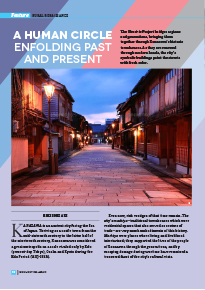Home > Highlighting JAPAN >Highlighting Japan June 2015>Rural Renaissance
Highlighting JAPAN

Rural Renaissance
A Human Circle Enfolding Past and Present
The Okuri-ie Project bridges regions and generations, bringing them together through Kanazawa’s historic townhouses. As they are renewed through modern hands, the city’s symbolic buildings paint the streets with fresh color.

Kanazawa is an ancient city facing the Sea of Japan. Thriving as a castle town from the mid-sixteenth century to the latter half of the nineteenth century, Kanazawa was considered a great metropolis on a scale rivaled only by Edo (present-day Tokyo), Osaka and Kyoto during the Edo Period (1603-1868).
Even now, rich vestiges of that time remain. The city’s machiya—traditional townhouses which were residential spaces that also served as centers of trade—are very much embodiments of this history. Machiya were places where living and livelihood intertwined; they supported the lives of the people of Kanazawa through the generations, and by escaping damage during wartime have remained a treasured facet of the city’s cultural vista.
However, many machiya are now home to elderly people who live alone, and as their owners move on or pass away, even such historic dwellings are increasingly subject to demolition, with two hundred townhouses a year reportedly suffering that fate.
In 2009, Kanazawa architectural designer Noriko Yamada began the Okuri-ie (“House Send-off”) Project, hoping to lend some warmth to the final farewells of these townhouses. Working through the day, project participants take rags in hand to scour vacant townhouses that might not have been cleaned in years. They’re allowed to take home trinkets such as small antiques and old books from the mountain of garbage that typically emerges. Carried out in a simple, pressure-free manner—and mostly on weekends—the Okuri-ie events draw people of all ages, with some even coming from distant cities such as Tokyo and Nagoya. A total of five thousand people have been involved in thirty Okuri-ie events to date, with the busiest day drawing more than two hundred participants.
People come for a number of reasons, ranging from the desire to get a sense of machiya life to the chance to meet people who share their ideals. Japan’s aging population and declining birthrate have made empty houses a major challenge in many regions, and some people are simply looking for hints for starting this kind of project in their own area. When three generations of the same family took part, the elders were pleased to see that even children who had only known how to clean with a vacuum were able to contribute, adding, “It was a good opportunity for them to learn what it’s like to clean with a cloth the old-fashioned way.”
“With every wipe of a cloth, human warmth is brought into these houses, dispelling the stagnant atmosphere,” Yamada says. “You can tell the houses are happy. As soon as you start cleaning a machiya together, even strangers are united in friendship. Through the old objects we find while cleaning, there’s an exchange between the young and the old. The divides between generations and regions can be breached through these houses, bringing people together.”
Concentrating on traditional homes with nearly a century of history, the project has opened the door to a number of intriguing events. “Relatives separated for thirty years have been brought back together, and participants have cleaned the homes of people who were once their classmates—miraculous things often happen,” Yamada recounts. “Maybe we’re calling up an unseen power. It’s fun to connect people to people, and people to objects. It’d be lovely if people poured their hearts into it and the practice of okuri-ie took root across Japan.”
Thanks to the patient efforts of Yamada and many others, the project has led to rising recognition of the worth of machiya in recent years, with more and more houses being handed on rather than demolished. Instead of a “send-off,” the Okuri-ie Project is increasingly becoming a “hand-off,” with the appeal of Kanazawa’s symbolic buildings being conveyed across regions and generations. The hands of modern people are now carving a new history into these machiya, bringing fresh vibrancy to the streets of Kanazawa.
© 2009 Cabinet Office, Government of Japan






